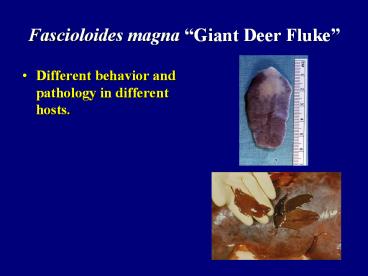Fascioloides%20magna%20 - PowerPoint PPT Presentation
Title:
Fascioloides%20magna%20
Description:
Fascioloides magna Giant Deer Fluke Different behavior and pathology in different hosts. Fascioloides magna Giant Deer Fluke Deer and Elk (normal hosts ... – PowerPoint PPT presentation
Number of Views:371
Avg rating:3.0/5.0
Title: Fascioloides%20magna%20
1
Fascioloides magna Giant Deer Fluke
- Different behavior and pathology in different
hosts.
2
Fascioloides magna Giant Deer Fluke
- Deer and Elk (normal hosts)Liver migration, then
matures in thin-walled fibrous cysts connected
with bile ducts. (Well tolerated eggs shed in
feces).
3
Fascioloides magna Giant Deer Fluke
- Cattle, bison and swineLiver migration, then
encapsulation in thick-walled, closed cysts and
no eggs are shed!
4
Fascioloides magna Giant Deer Fluke
- Sheep and goats extensive, uninterrupted hepatic
migration with out encapsulation usually fatal
1 fluke can kill a sheep or goat!
5
Pathology
- Pathology in C. sinensis and D. dendriticum
distended bile ducts and erosion of epithelium
lining, but no secondary pathology like in F.
hepatica!
6
Treatment
- Preziquantel (except for F. hepatica).
- Rafoxanide is the drug of choice for F. hepatica!
7
Diagnosis
- Look for eggs in feces!
- But hard to diagnose (why?).
- SPURIOUS INFECTIONS!
8
Aquatic Vegetation
Water Chestnuts
9
Pickled Fish
10
Digestive Tract Trematodes
11
Fasciolopsis buski
- Order Echinostomatiformes
- Humans, pigs
- Orient
- Large (7.5 cm)
- Life cycle similar to Fasciola
12
(No Transcript)
13
Pathology and Symptoms
- Severity depends on worm burden
- Irritation
- Excess mucous secretion
- Ulceration, hemorrhage, Abscess
- Obstruction
- Chronic diarrhea
- Sensitization to worm metabolites
- Leukocytosis
- Anemia
- Eosinophilia
- Nausea/diarrhea
- Edema of face and intestinal wall
- Death
14
Treatment
- Praziquantel
15
Epidemiology
- Who gets infected?
- Rural to semi-urban areas
- School age children
- Prevalence
- 57 China
- 25 Taiwan
- 50 Bangladesh
- 60 India
- 10 Thailand
16
Epidemiology
- How do you get fasciolopsiasis?
- Ingest metacercariae
- Commercially raised aquatic plants
- Water chestnut
- Water caltrop
- Water hyacinth
- Water lotus
- Water lily
- Watercress
17
Epidemiology
- Lack of regulation on food industry
- Food preparation
- Sanitation (sewage)
- Night soil
- Pigs
- Habitat
- Food
18
Digestive Tract Trematodes
- FAMILY ECHINOSTOMATIDAE - intestinal parasites
recognized by their anterior collar of spines. - Echinostoma revolutum - Cosmopolitan parasite of
birds and mammals shows low host specificity - Human cases?
19
Morphology of Adult Echinostoma revolutum
Adults are elongate, up to an inch in
length. Characteristic structure is their
circumoral collar of spines arranged in two
rows. 37 spines in E. revolutum. Internal
organs are distinct and easy to identify.
20
Morphology of Adult Echinostoma revolutum
Collar of spines around oral sucker
uterus
Vitellaria Testes Mehlis
gland Ovary
21
Life Cycle of Echinostoma revolutum
Parasite shows low host specificity throughout
cycle 1. Adults occur in birds and
mammals. 2. Eggs are released via the feces
into an aquatic habitat. 3. Miracidia hatch,
swim to snail, and penetrate.
22
Life Cycle of Echinostoma revolutum
4. Sporocysts and rediae occur within snail.
Cercariae are released. 5. Cercariae penetrate
(2nd intermediate hosts) and encyst as
metacercariae. 6. Definitive host is infected
by ingesting 2nd intermediate host,
metacercariae excyst in stomach, and adults
mature in small intestine.
23
Order Plagiorchiformes
- Family Troglotrematidae these are oval thick
flukes with a spiny tegument and dense
vitellaria. - Parasites of lungs, intestine, nasal passages,
cranial cavities, and various ectopic locations.
24
Nanophyetus salmincola
25
Nanophyetus salmincola
- Northwest N. America
- Northeast Asia
- Crypts of the small intestine
- Human infections
- 98 prevalence in Siberian villages
- Pathology
26
Nanophyetus salmincola
- Salmon poisoning
- Highly pathogenic
- Neorickettsia helminthoeca
- Rickettsia
- Intracellular bacterium
- Typhus
- Nanophyetus salmincola is a vector for
Neorickettsia helminthoeca.
27
Nanophyetus salmincola
- Disease
- High Fever
- Edema of face
- Vomiting
- Diarrhea
- Death in 10 days to 2 weeks.
28
Lung Flukes
- Paragonimus
- bronchiolar lumen and peribronchial tissues
- Antigenic
- Become encapsulated
- granuloma
29
Paragonimiasis
- Paragonimus
- 7 species in Asia, Sub-Saharan Africa, Central
and South America - Paragonimus westermani
30
Life cycle of Paragonimus
31
Paragonimus cercaria
32
Paragonimus westermani
- 1st Int. Host
- Freshwater snails
- Streams
- Rice paddies
Melanoides tuberculata
33
Paragonimus westermani
- 2nd Int. Hosts
- Potamon
- Rice Paddies
- Eriocheir
- Streams
- Larvae develop in brackish water
34
Paragonimus kellicotti
- Crayfish serve as 2nd IH in North America.
- Metacercariae are found in the heart.
35
Paragonimus
- A number of birds and mammals are know to serve
as PH! - Guinea pigs are known to serve as PARATENIC HOSTS
for Paraganimus spp. in South America!































![[PDF⚡READ❤ONLINE] The Magna Carta of Humanity: Sinai's Revolutionary Faith and the Future of PowerPoint PPT Presentation](https://s3.amazonaws.com/images.powershow.com/10039928.th0.jpg?_=20240527073)